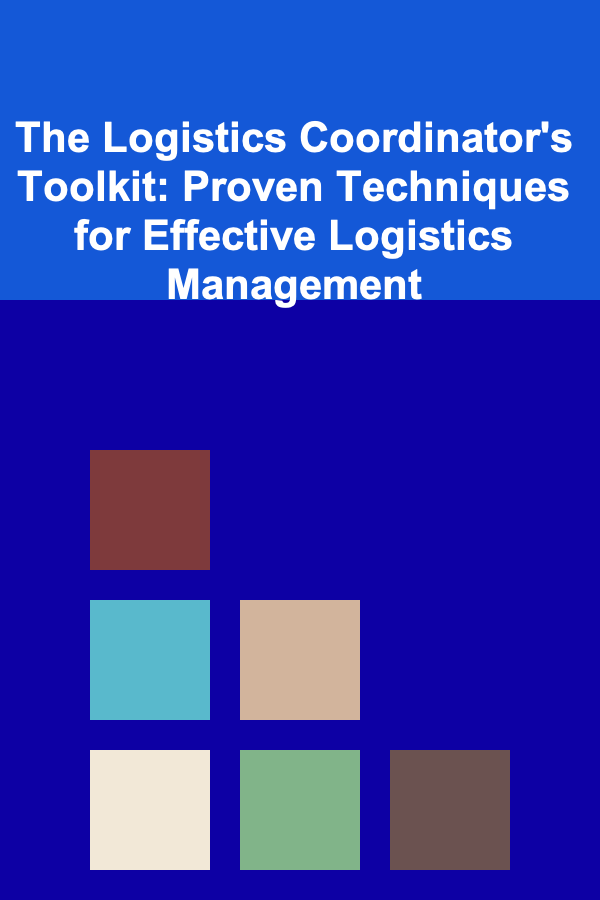
How to Create a Checklist for Employee Performance Reviews
ebook include PDF & Audio bundle (Micro Guide)
$12.99$8.99
Limited Time Offer! Order within the next:

Employee performance reviews are an essential part of the workplace. They not only help employers assess an employee's performance but also provide valuable feedback to help individuals grow and develop in their roles. A well-structured performance review can increase motivation, enhance communication, and identify areas for improvement. However, to make these reviews truly effective, you need a comprehensive and actionable checklist that guides both managers and employees throughout the process.
Creating a checklist for employee performance reviews ensures consistency, fairness, and transparency. It allows the manager to evaluate performance objectively while also providing employees with clear feedback and actionable steps for improvement.
Understand the Purpose of Employee Performance Reviews
Before jumping into the checklist itself, it's important to define the purpose of performance reviews. These reviews aim to:
- Assess individual performance: Understand how well an employee has met their job responsibilities, goals, and KPIs (Key Performance Indicators).
- Provide constructive feedback: Offer insights into strengths and areas for development.
- Set new goals: Identify new objectives and challenges for the upcoming period.
- Recognize achievements: Acknowledge the accomplishments and contributions of the employee.
- Facilitate career development: Discuss the employee's career aspirations and professional growth opportunities.
The checklist you create should serve all these goals, providing a clear, structured approach for both evaluators and employees.
Determine Key Performance Areas
The first step in developing an effective checklist is identifying the core areas you want to evaluate. These areas should align with the employee's role, responsibilities, and the company's strategic objectives. Key performance areas typically include the following:
a. Job Knowledge and Skills
- Does the employee demonstrate the necessary knowledge and technical expertise required for the role?
- Are they staying current with industry trends and best practices?
- Do they apply their skills effectively to solve problems and complete tasks?
b. Quality of Work
- Is the employee's work consistently accurate and of high quality?
- Do they meet established quality standards?
- Are they detail-oriented and thorough in their work?
c. Productivity and Efficiency
- Does the employee complete tasks in a timely manner without sacrificing quality?
- How well do they manage time and prioritize tasks?
- Are they consistently meeting deadlines?
d. Communication Skills
- How well does the employee communicate with colleagues, supervisors, and clients?
- Are they clear, concise, and respectful in their communication?
- Do they actively listen and respond to feedback?
e. Collaboration and Teamwork
- How well does the employee work with others in a team setting?
- Are they supportive of their teammates and contribute to a positive team dynamic?
- Do they resolve conflicts constructively?
f. Problem-Solving and Initiative
- Does the employee take initiative and show a willingness to solve problems on their own?
- Are they creative in their problem-solving approach?
- Do they suggest improvements and actively work to streamline processes?
g. Leadership and Management (if applicable)
- For employees in leadership roles, how effectively do they manage their team?
- Do they inspire and motivate others?
- Are they making decisions that benefit both the team and the company?
h. Attendance and Punctuality
- Does the employee consistently show up on time and adhere to their work schedule?
- How reliable are they in terms of attendance?
i. Adaptability and Flexibility
- How well does the employee adapt to changes in the workplace or work environment?
- Are they open to new ideas, feedback, and changes in processes?
- Do they handle stress and pressure effectively?
Define Clear Rating Scales
It's essential to create a standardized rating system that makes it easier to assess performance objectively. A common method is using a numerical scale, such as:
- 1 - Needs Improvement: The employee's performance is below expectations and requires significant development in this area.
- 2 - Meets Expectations: The employee's performance is satisfactory and meets the standard requirements for the role.
- 3 - Exceeds Expectations: The employee consistently goes beyond what is expected, demonstrating exceptional performance.
- 4 - Outstanding: The employee's performance is exceptional in every aspect, and they significantly contribute to the success of the team and company.
Make sure that the criteria for each rating are clearly defined so that both the reviewer and the employee have a shared understanding of what each level means.
Incorporate Employee Self-Assessment
Employee self-assessment is a valuable tool in the performance review process. It encourages employees to reflect on their own performance, achievements, and areas for improvement. Including a self-assessment section in the checklist can provide a comprehensive perspective of the employee's performance.
Key Self-Assessment Questions:
- What achievements are you most proud of in this review period?
- What challenges did you face, and how did you overcome them?
- How have you contributed to team or company goals?
- In which areas do you think you can improve, and how do you plan to address these?
- What professional development opportunities are you interested in pursuing?
By incorporating self-assessment, you create a two-way conversation where both the manager and the employee can discuss goals and concerns more openly.
Set SMART Goals
Setting clear, measurable goals is one of the most important outcomes of a performance review. Using the SMART framework (Specific, Measurable, Achievable, Relevant, and Time-bound) ensures that goals are clear and actionable.
Example of SMART Goals:
- Specific: Increase sales by 10% in the next quarter by focusing on high-potential clients.
- Measurable: Achieve an average customer satisfaction score of 90% or higher over the next six months.
- Achievable: Complete a leadership training program within the next 12 months to improve team management skills.
- Relevant: Develop cross-departmental communication skills to enhance collaboration with marketing and product teams.
- Time-bound: Submit a proposal for process improvements by the end of the month.
Ensure that each goal is tied to the employee's job responsibilities and aligns with broader organizational objectives. Goals should be realistic but also challenging enough to encourage growth.
Include Space for Feedback and Development Plans
Feedback is a crucial part of the performance review process. Constructive feedback should be specific, actionable, and delivered in a way that motivates the employee to improve. When providing feedback, it's helpful to:
- Highlight both strengths and areas for improvement.
- Use examples to clarify your points.
- Focus on behavior or outcomes, not personal traits.
- Be supportive and offer solutions or resources to help the employee improve.
Additionally, include a section in your checklist for creating a development plan. This plan should outline steps the employee can take to improve their performance and skills. This can include:
- Training or courses
- Mentorship or coaching
- New responsibilities or projects
- Time management strategies
Discuss Career Development and Aspirations
Performance reviews are not just about assessing current performance but also about planning for future growth. Take the time to discuss the employee's career goals and how they align with the company's objectives. This discussion can help you:
- Identify opportunities for professional development.
- Offer guidance and support for career progression.
- Enhance employee engagement and retention by showing interest in their growth.
Key Questions for Career Development:
- What are your long-term career goals?
- How do you envision growing within the company?
- Are there any skills or experiences you'd like to develop?
- What opportunities within the company would help you achieve your career objectives?
Regular Follow-ups and Continuous Feedback
A performance review should not be a one-time event. To keep employees on track and help them achieve their goals, regular check-ins and ongoing feedback are crucial. Schedule quarterly or biannual meetings to discuss progress, adjust goals, and address any challenges.
By maintaining an open line of communication, you ensure that performance reviews become a continuous development process rather than a yearly or one-time assessment.
Conclusion
Creating a checklist for employee performance reviews is not just about measuring performance; it's about fostering growth, development, and a positive working environment. By focusing on key performance areas, setting SMART goals, incorporating feedback and development plans, and supporting career growth, you provide your employees with the tools they need to succeed and thrive within your organization.
A well-designed checklist ensures that the review process is objective, consistent, and comprehensive. It can also increase employee engagement by giving them clear direction and a sense of accomplishment. Make performance reviews a valuable part of your organization's culture, and watch your team's productivity and morale soar.
Reading More From Our Other Websites
- [Organization Tip 101] How to Use Financial Literacy Resources for Better Budgeting
- [Organization Tip 101] How to Customize Your Jewelry Organizer for Unique Needs
- [Organization Tip 101] How to Create a Garage Inventory List for Easy Tracking
- [Soap Making Tip 101] The Cold-Process Countdown: Managing Time-Sensitive Steps and Preventing Batch Failures
- [Organization Tip 101] How to Designate a Study Area with Organized Materials
- [Hiking with Kids Tip 101] Trail Tails: Dog‑Friendly Hikes Every Family Will Love
- [Horseback Riding Tip 101] Comparing Horse Riding Lesson Prices: Private vs. Group Sessions Explained
- [Horseback Riding Tip 101] Hidden Costs of Horse Riding Lessons: What to Expect Beyond the Hourly Rate
- [Personal Finance Management 101] How to Maximize Your Tax Deductions and Minimize Tax Liability
- [Home Space Saving 101] How to Choose the Perfect Space-Saving Coat Rack for Every Room in Your Home

How to Create a Personalized Organization System That Works for You
Read More
How to Maintain Your Pet's Physical and Mental Health Together
Read More
The Logistics Coordinator's Toolkit: Proven Techniques for Effective Logistics Management
Read More
How to Support International Treaties for Wildlife
Read More
How to Design a Customer Service Planner for a Small Retail Business
Read More
How to Master the Fundamentals of Aikido for Self-Defense
Read MoreOther Products

How to Create a Personalized Organization System That Works for You
Read More
How to Maintain Your Pet's Physical and Mental Health Together
Read More
The Logistics Coordinator's Toolkit: Proven Techniques for Effective Logistics Management
Read More
How to Support International Treaties for Wildlife
Read More
How to Design a Customer Service Planner for a Small Retail Business
Read More